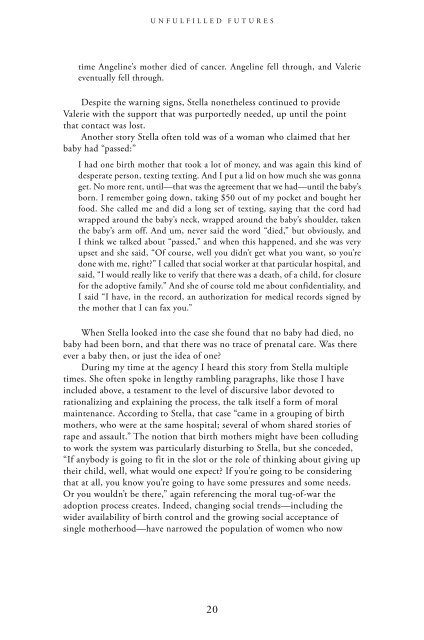DEFINING PROBLEMS. SHAPING SOLUTIONS . - School of Social Service ...
DEFINING PROBLEMS. SHAPING SOLUTIONS . - School of Social Service ...
DEFINING PROBLEMS. SHAPING SOLUTIONS . - School of Social Service ...
Create successful ePaper yourself
Turn your PDF publications into a flip-book with our unique Google optimized e-Paper software.
U N F U L F I L L E D F U T U R E S<br />
time Angeline’s mother died <strong>of</strong> cancer. Angeline fell through, and Valerie<br />
eventually fell through.<br />
Despite the warning signs, Stella nonetheless continued to provide<br />
Valerie with the support that was purportedly needed, up until the point<br />
that contact was lost.<br />
Another story Stella <strong>of</strong>ten told was <strong>of</strong> a woman who claimed that her<br />
baby had “passed:”<br />
I had one birth mother that took a lot <strong>of</strong> money, and was again this kind <strong>of</strong><br />
desperate person, texting texting. And I put a lid on how much she was gonna<br />
get. No more rent, until—that was the agreement that we had—until the baby’s<br />
born. I remember going down, taking $50 out <strong>of</strong> my pocket and bought her<br />
food. She called me and did a long set <strong>of</strong> texting, saying that the cord had<br />
wrapped around the baby’s neck, wrapped around the baby’s shoulder, taken<br />
the baby’s arm <strong>of</strong>f. And um, never said the word “died,” but obviously, and<br />
I think we talked about “passed,” and when this happened, and she was very<br />
upset and she said, “Of course, well you didn’t get what you want, so you’re<br />
done with me, right?” I called that social worker at that particular hospital, and<br />
said, “I would really like to verify that there was a death, <strong>of</strong> a child, for closure<br />
for the adoptive family.” And she <strong>of</strong> course told me about confidentiality, and<br />
I said “I have, in the record, an authorization for medical records signed by<br />
the mother that I can fax you.”<br />
When Stella looked into the case she found that no baby had died, no<br />
baby had been born, and that there was no trace <strong>of</strong> prenatal care. Was there<br />
ever a baby then, or just the idea <strong>of</strong> one?<br />
During my time at the agency I heard this story from Stella multiple<br />
times. She <strong>of</strong>ten spoke in lengthy rambling paragraphs, like those I have<br />
included above, a testament to the level <strong>of</strong> discursive labor devoted to<br />
rationalizing and explaining the process, the talk itself a form <strong>of</strong> moral<br />
maintenance. According to Stella, that case “came in a grouping <strong>of</strong> birth<br />
mothers, who were at the same hospital; several <strong>of</strong> whom shared stories <strong>of</strong><br />
rape and assault.” The notion that birth mothers might have been colluding<br />
to work the system was particularly disturbing to Stella, but she conceded,<br />
“If anybody is going to fit in the slot or the role <strong>of</strong> thinking about giving up<br />
their child, well, what would one expect? If you’re going to be considering<br />
that at all, you know you’re going to have some pressures and some needs.<br />
Or you wouldn’t be there,” again referencing the moral tug-<strong>of</strong>-war the<br />
adoption process creates. Indeed, changing social trends—including the<br />
wider availability <strong>of</strong> birth control and the growing social acceptance <strong>of</strong><br />
single motherhood—have narrowed the population <strong>of</strong> women who now<br />
20
















